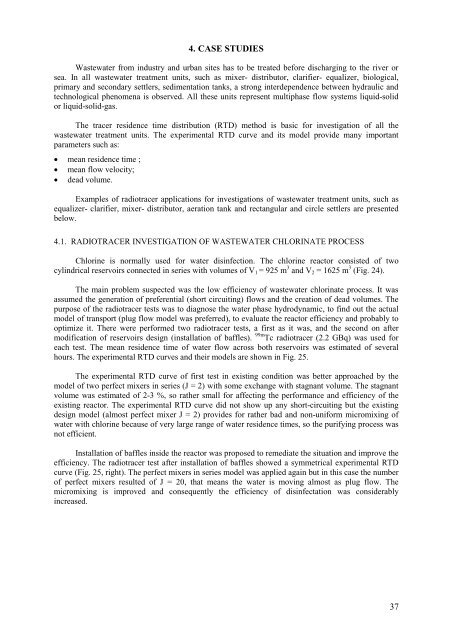Download file - Ayuntamiento de Zaragoza
Download file - Ayuntamiento de Zaragoza
Download file - Ayuntamiento de Zaragoza
Create successful ePaper yourself
Turn your PDF publications into a flip-book with our unique Google optimized e-Paper software.
4. CASE STUDIESWastewater from industry and urban sites has to be treated before discharging to the river orsea. In all wastewater treatment units, such as mixer- distributor, clarifier- equalizer, biological,primary and secondary settlers, sedimentation tanks, a strong inter<strong>de</strong>pen<strong>de</strong>nce between hydraulic andtechnological phenomena is observed. All these units represent multiphase flow systems liquid-solidor liquid-solid-gas.The tracer resi<strong>de</strong>nce time distribution (RTD) method is basic for investigation of all thewastewater treatment units. The experimental RTD curve and its mo<strong>de</strong>l provi<strong>de</strong> many importantparameters such as:• mean resi<strong>de</strong>nce time ;• mean flow velocity;• <strong>de</strong>ad volume.Examples of radiotracer applications for investigations of wastewater treatment units, such asequalizer- clarifier, mixer- distributor, aeration tank and rectangular and circle settlers are presentedbelow.4.1. RADIOTRACER INVESTIGATION OF WASTEWATER CHLORINATE PROCESSChlorine is normally used for water disinfection. The chlorine reactor consisted of twocylindrical reservoirs connected in series with volumes of V 1 = 925 m 3 and V 2 = 1625 m 3 (Fig. 24).The main problem suspected was the low efficiency of wastewater chlorinate process. It wasassumed the generation of preferential (short circuiting) flows and the creation of <strong>de</strong>ad volumes. Thepurpose of the radiotracer tests was to diagnose the water phase hydrodynamic, to find out the actualmo<strong>de</strong>l of transport (plug flow mo<strong>de</strong>l was preferred), to evaluate the reactor efficiency and probably tooptimize it. There were performed two radiotracer tests, a first as it was, and the second on aftermodification of reservoirs <strong>de</strong>sign (installation of baffles). 99m Tc radiotracer (2.2 GBq) was used foreach test. The mean resi<strong>de</strong>nce time of water flow across both reservoirs was estimated of severalhours. The experimental RTD curves and their mo<strong>de</strong>ls are shown in Fig. 25.The experimental RTD curve of first test in existing condition was better approached by themo<strong>de</strong>l of two perfect mixers in series (J = 2) with some exchange with stagnant volume. The stagnantvolume was estimated of 2-3 %, so rather small for affecting the performance and efficiency of theexisting reactor. The experimental RTD curve did not show up any short-circuiting but the existing<strong>de</strong>sign mo<strong>de</strong>l (almost perfect mixer J = 2) provi<strong>de</strong>s for rather bad and non-uniform micromixing ofwater with chlorine because of very large range of water resi<strong>de</strong>nce times, so the purifying process wasnot efficient.Installation of baffles insi<strong>de</strong> the reactor was proposed to remediate the situation and improve theefficiency. The radiotracer test after installation of baffles showed a symmetrical experimental RTDcurve (Fig. 25, right). The perfect mixers in series mo<strong>de</strong>l was applied again but in this case the numberof perfect mixers resulted of J = 20, that means the water is moving almost as plug flow. Themicromixing is improved and consequently the efficiency of disinfectation was consi<strong>de</strong>rablyincreased.37
















